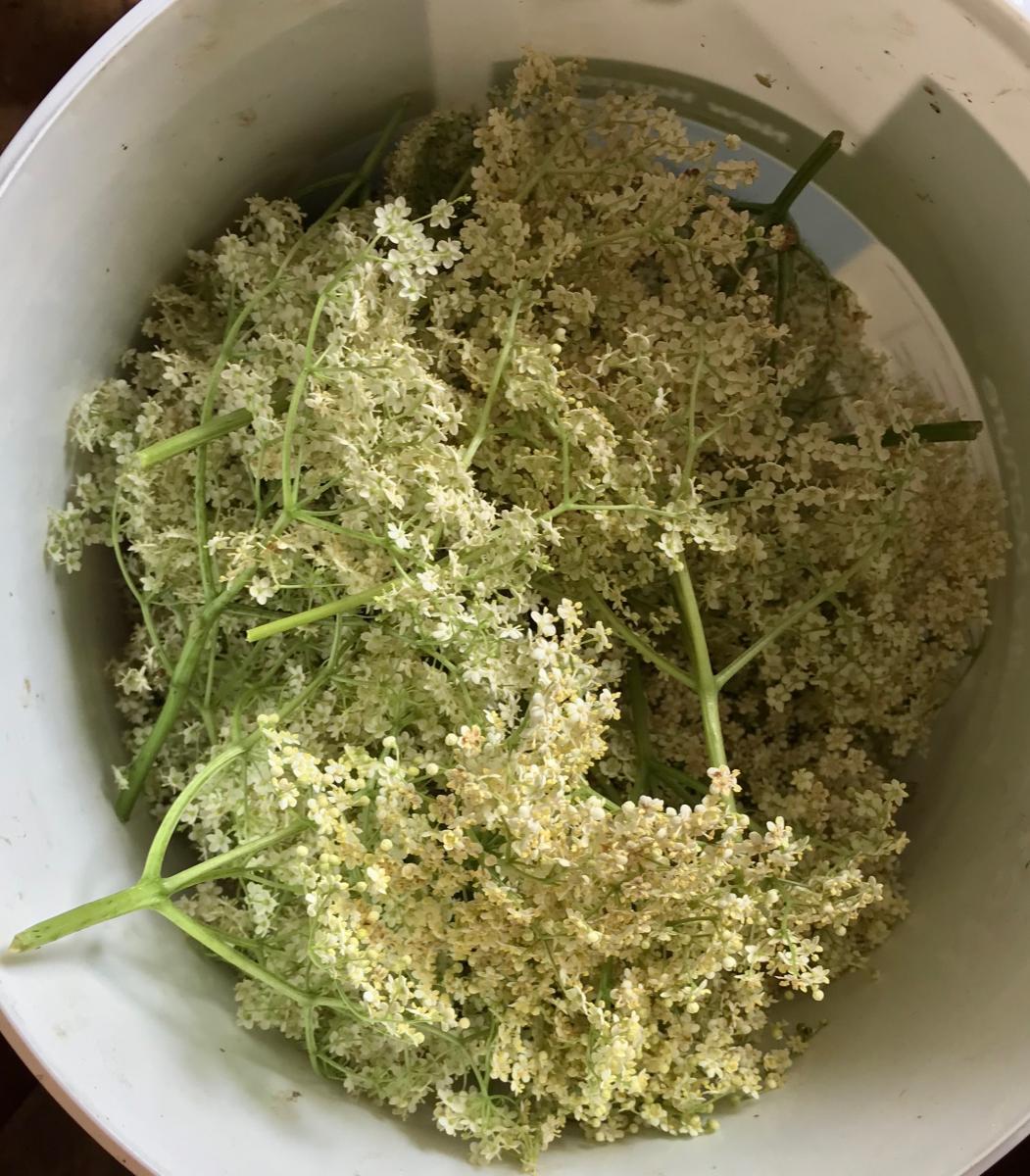The hedgerows are filled with creamy elderflowers. It’s time to forage! Choose elderflower heads that are in full blossom and at their most fragrant to make delicious drinks, skin care and preserves. If you can, try to collect your flowers from areas without too much traffic pollution and above the ‘wee line’. (Imagine a passing wild animal or dog passing by and needing a wee – so picking 60cm or so above the ground should be ok.) Choose elderflower heads with open flowers and no brown bits. Check carefully for blackfly and other bugs.

Tip! If you are not familiar with elder trees, do get someone who is to come on your forage with you. The tree has a very distinctive smell – the flowers are gorgeous, the leaves and bark not so much (can smell a bit like stale cat wee) – but there are other frothy white flowers in the hedgerows at this time of year and some of them are toxic. Leave your collected flowerheads uncovered for half an hour or so, if you can, to allow any hitchhikers to crawl away.
In all of these recipes I have removed the blossom from the stalks with my fingers.
1 gallon / 4.55 litres water
1 1/4 lb/ 570g sugar
12 heads elderflowers blossoms
1 lemon sliced
2 tbsp white wine vinegar
Boil the water and pour into a fermentation bucket. Add the sugar and stir until dissolved. Leave to cool.
Add the flowers, slices of lemon and wine vinegar and stir. Replace the lid and leave for a week, stirring daily. Elderflowers have their own natural wild yeasts but if after 4 days the wine hasn’t started to ferment, add a packet of champagne yeast to get things moving. After a week, strain the wine through muslin into a large clean container. Cover with a damp tea towel and leave for a few hours for the sediment to settle.
Syphon off into strong champagne style bottles or plastic bottles (clean recycled ones) and cork. It will be ready to drink in a week.
**Put the bottles in a secure place, they can be very explosive! Inside a box in a shed, or in the cupboard under the stairs, so that if they explode it doesn’t go everywhere. If you are using screw tops, check every day and release the pressure slightly.**
1 litre vodka
20 heads elderflowers
1 lemon, zest
125g sugar
Remove the zest from the lemon with a microplane or zester. (Tip: if you are not going to use the rest of the lemon soon, slice it up and pop it in the freezer. It makes lovely lemon ‘ice cubes’ for summer drinks.)
Place the blossoms in a large jar and add the sugar and lemon zest. Pour over the vodka, stir and replace the lid.
Shake daily for two weeks and then place in a cool dark place to infuse for at least two months. Strain through a muslin lined sieve and pour into clean, labelled bottles. Alternatively, use gin or white rum.

12 heads elderflowers
500 ml white wine or champagne vinegar
This delicious vinegar can be used to make salad dressings, as a cordial (with something sweet added: sugar, agave, maple syrup, honey) and in home-made cosmetics including hair rinses and skin splashes.
Simply put the elderflowers and vinegar in a jar, replace the lid and shake. Allow the vinegar to infuse for two weeks, sharing daily then strain through a sieve lined with muslin or a jelly bag and pour into a clean, labelled bottle. You can use cider vinegar if you prefer.
To make a skin toner, use the same method but replace the vinegar with witch hazel.
1 part elderflowers
3 parts (I used half olive and half grapeseed)
Place your elderflowers in a jar. Fill with approximately 3 times as much oil. It doesn’t have to be exact, but if you prefer weigh the elderflowers and measure out three times that quantity of oil. Stir and place something on top to help keep the elderflowers submerged, such as a plastic canning lid. Leave in a cool dark place for 2-3 weeks.
Strain through a muslin lined sieve and pour into a clean labelled jar. The oil can be used in the kitchen, but I mainly make it to make soaps, salves and other body products. Elderflower oil is soothing, anti-inflammatory and kind to the skin.
You will need:
elderflowers
sugar
Layer sugar and elderflower blossoms alternately in a jar. When full, stir and replace the lid. Leave for two weeks, stirring occasionally to break up any lumps.
This sugar is delicious in baking, as a topping and to fragrantly sweeten beverages.
I still had some elderflower heads left, so I lined a blue plastic mushroom crate with a clean tea towel, spread the blossom over the base and popped it in the airing cupboard. It will take a week or two to dry. When the blossoms are quite dry, pour into a clean labelled jar. Use to make elderflower tea or infusions for homemade skin care products.
The Creative Kitchen
by Stephanie Hafferty
No Dig Organic Home and Garden
by Stephanie Hafferty and Charles Dowding
Stephanie Hafferty is a no dig gardener, writer and author of The Creative Kitchen and coauthor of No Dig Organic Home and Garden.











